Organizational Learning & Change: A Sanitarium Health Case Study
VerifiedAdded on 2023/06/04
|10
|2553
|377
Case Study
AI Summary
This case study examines Sanitarium Health and Wellbeing's organizational culture, change management policies, and learning mechanisms. The analysis diagnoses the company's 'Role Culture,' evaluates the success of its change efforts using tools like OCI and OEI, and explores factors influencing outcomes such as organizational citizenship, employee valuation, and training programs. Various learning mechanisms, including e-learning, on-the-job training, and peer coaching, are critically analyzed for their impact on organizational performance and employee engagement. The study concludes with recommendations for future learning and change initiatives, such as individualized skill development plans and job rotations, to further enhance employee engagement and organizational growth. Desklib provides access to a wealth of similar case studies and learning resources.
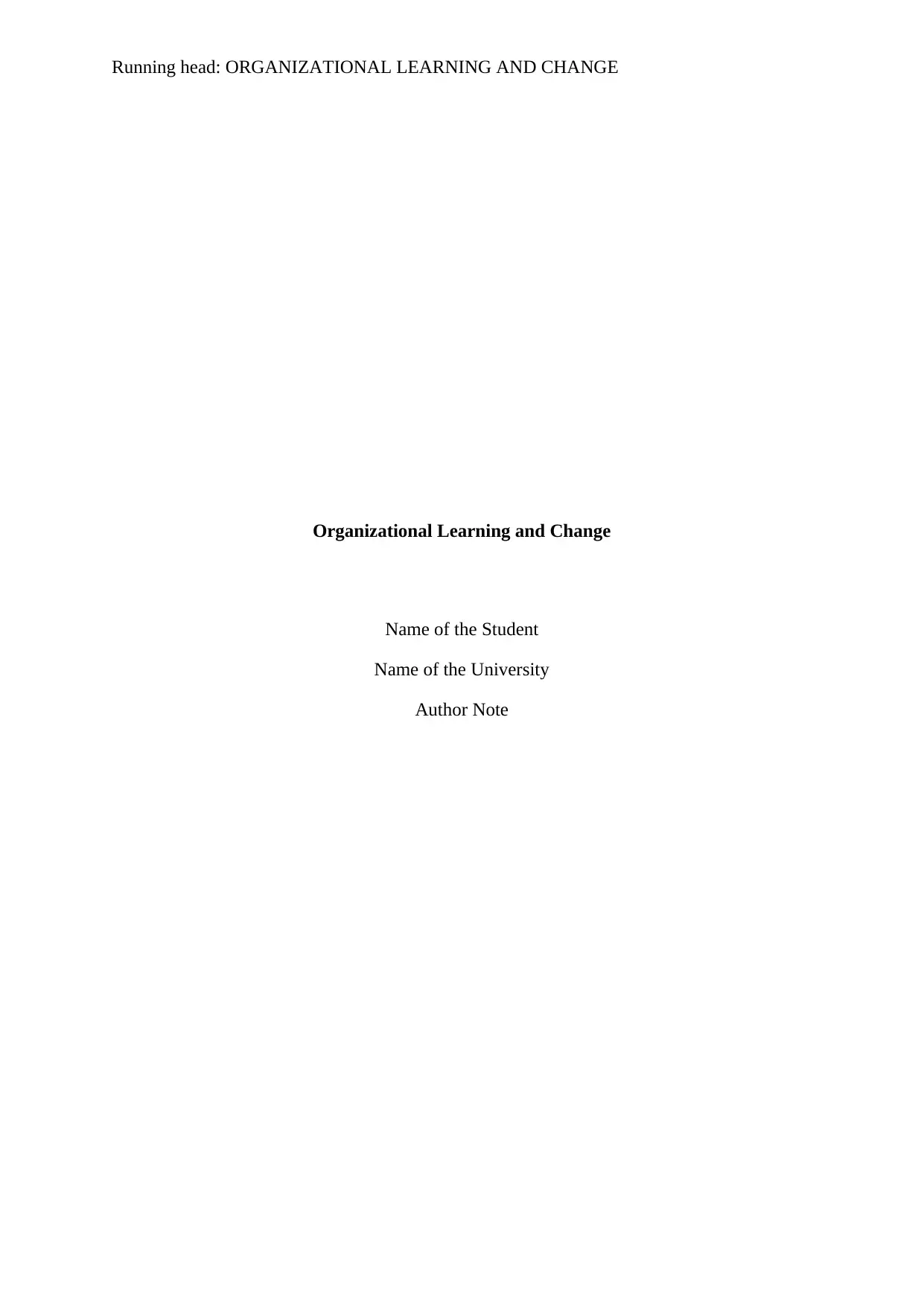
Running head: ORGANIZATIONAL LEARNING AND CHANGE
Organizational Learning and Change
Name of the Student
Name of the University
Author Note
Organizational Learning and Change
Name of the Student
Name of the University
Author Note
Paraphrase This Document
Need a fresh take? Get an instant paraphrase of this document with our AI Paraphraser
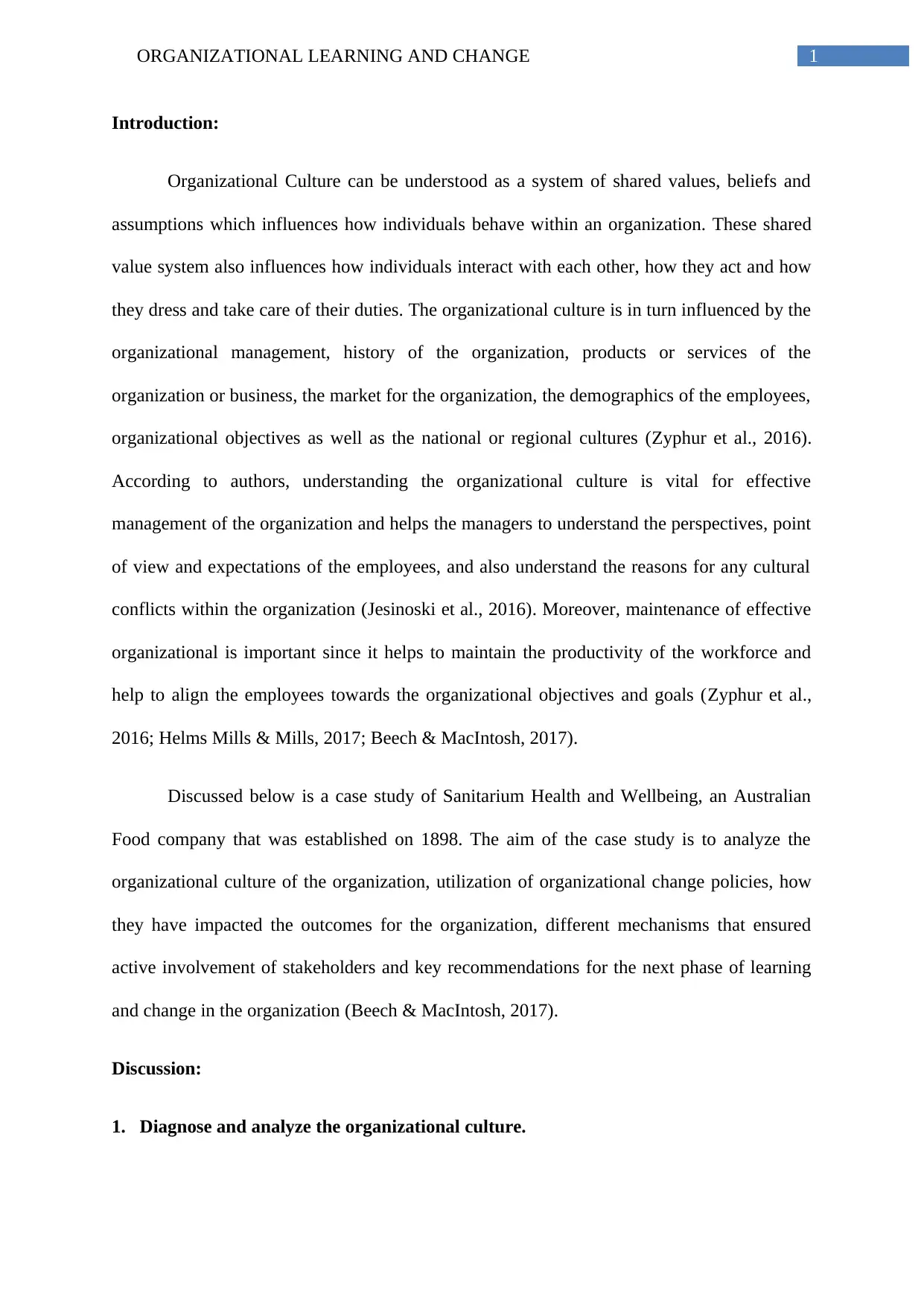
1ORGANIZATIONAL LEARNING AND CHANGE
Introduction:
Organizational Culture can be understood as a system of shared values, beliefs and
assumptions which influences how individuals behave within an organization. These shared
value system also influences how individuals interact with each other, how they act and how
they dress and take care of their duties. The organizational culture is in turn influenced by the
organizational management, history of the organization, products or services of the
organization or business, the market for the organization, the demographics of the employees,
organizational objectives as well as the national or regional cultures (Zyphur et al., 2016).
According to authors, understanding the organizational culture is vital for effective
management of the organization and helps the managers to understand the perspectives, point
of view and expectations of the employees, and also understand the reasons for any cultural
conflicts within the organization (Jesinoski et al., 2016). Moreover, maintenance of effective
organizational is important since it helps to maintain the productivity of the workforce and
help to align the employees towards the organizational objectives and goals (Zyphur et al.,
2016; Helms Mills & Mills, 2017; Beech & MacIntosh, 2017).
Discussed below is a case study of Sanitarium Health and Wellbeing, an Australian
Food company that was established on 1898. The aim of the case study is to analyze the
organizational culture of the organization, utilization of organizational change policies, how
they have impacted the outcomes for the organization, different mechanisms that ensured
active involvement of stakeholders and key recommendations for the next phase of learning
and change in the organization (Beech & MacIntosh, 2017).
Discussion:
1. Diagnose and analyze the organizational culture.
Introduction:
Organizational Culture can be understood as a system of shared values, beliefs and
assumptions which influences how individuals behave within an organization. These shared
value system also influences how individuals interact with each other, how they act and how
they dress and take care of their duties. The organizational culture is in turn influenced by the
organizational management, history of the organization, products or services of the
organization or business, the market for the organization, the demographics of the employees,
organizational objectives as well as the national or regional cultures (Zyphur et al., 2016).
According to authors, understanding the organizational culture is vital for effective
management of the organization and helps the managers to understand the perspectives, point
of view and expectations of the employees, and also understand the reasons for any cultural
conflicts within the organization (Jesinoski et al., 2016). Moreover, maintenance of effective
organizational is important since it helps to maintain the productivity of the workforce and
help to align the employees towards the organizational objectives and goals (Zyphur et al.,
2016; Helms Mills & Mills, 2017; Beech & MacIntosh, 2017).
Discussed below is a case study of Sanitarium Health and Wellbeing, an Australian
Food company that was established on 1898. The aim of the case study is to analyze the
organizational culture of the organization, utilization of organizational change policies, how
they have impacted the outcomes for the organization, different mechanisms that ensured
active involvement of stakeholders and key recommendations for the next phase of learning
and change in the organization (Beech & MacIntosh, 2017).
Discussion:
1. Diagnose and analyze the organizational culture.
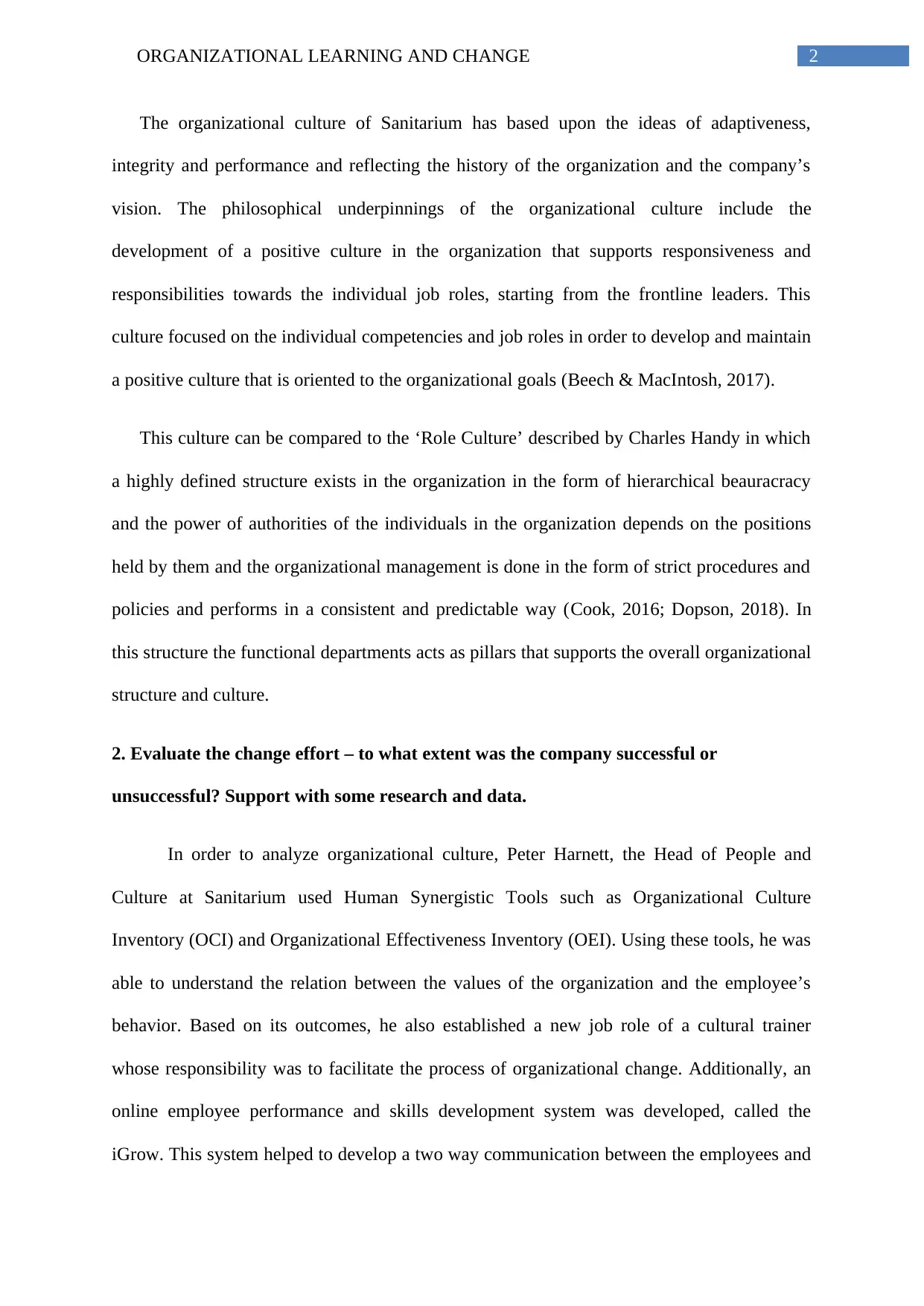
2ORGANIZATIONAL LEARNING AND CHANGE
The organizational culture of Sanitarium has based upon the ideas of adaptiveness,
integrity and performance and reflecting the history of the organization and the company’s
vision. The philosophical underpinnings of the organizational culture include the
development of a positive culture in the organization that supports responsiveness and
responsibilities towards the individual job roles, starting from the frontline leaders. This
culture focused on the individual competencies and job roles in order to develop and maintain
a positive culture that is oriented to the organizational goals (Beech & MacIntosh, 2017).
This culture can be compared to the ‘Role Culture’ described by Charles Handy in which
a highly defined structure exists in the organization in the form of hierarchical beauracracy
and the power of authorities of the individuals in the organization depends on the positions
held by them and the organizational management is done in the form of strict procedures and
policies and performs in a consistent and predictable way (Cook, 2016; Dopson, 2018). In
this structure the functional departments acts as pillars that supports the overall organizational
structure and culture.
2. Evaluate the change effort – to what extent was the company successful or
unsuccessful? Support with some research and data.
In order to analyze organizational culture, Peter Harnett, the Head of People and
Culture at Sanitarium used Human Synergistic Tools such as Organizational Culture
Inventory (OCI) and Organizational Effectiveness Inventory (OEI). Using these tools, he was
able to understand the relation between the values of the organization and the employee’s
behavior. Based on its outcomes, he also established a new job role of a cultural trainer
whose responsibility was to facilitate the process of organizational change. Additionally, an
online employee performance and skills development system was developed, called the
iGrow. This system helped to develop a two way communication between the employees and
The organizational culture of Sanitarium has based upon the ideas of adaptiveness,
integrity and performance and reflecting the history of the organization and the company’s
vision. The philosophical underpinnings of the organizational culture include the
development of a positive culture in the organization that supports responsiveness and
responsibilities towards the individual job roles, starting from the frontline leaders. This
culture focused on the individual competencies and job roles in order to develop and maintain
a positive culture that is oriented to the organizational goals (Beech & MacIntosh, 2017).
This culture can be compared to the ‘Role Culture’ described by Charles Handy in which
a highly defined structure exists in the organization in the form of hierarchical beauracracy
and the power of authorities of the individuals in the organization depends on the positions
held by them and the organizational management is done in the form of strict procedures and
policies and performs in a consistent and predictable way (Cook, 2016; Dopson, 2018). In
this structure the functional departments acts as pillars that supports the overall organizational
structure and culture.
2. Evaluate the change effort – to what extent was the company successful or
unsuccessful? Support with some research and data.
In order to analyze organizational culture, Peter Harnett, the Head of People and
Culture at Sanitarium used Human Synergistic Tools such as Organizational Culture
Inventory (OCI) and Organizational Effectiveness Inventory (OEI). Using these tools, he was
able to understand the relation between the values of the organization and the employee’s
behavior. Based on its outcomes, he also established a new job role of a cultural trainer
whose responsibility was to facilitate the process of organizational change. Additionally, an
online employee performance and skills development system was developed, called the
iGrow. This system helped to develop a two way communication between the employees and
⊘ This is a preview!⊘
Do you want full access?
Subscribe today to unlock all pages.

Trusted by 1+ million students worldwide
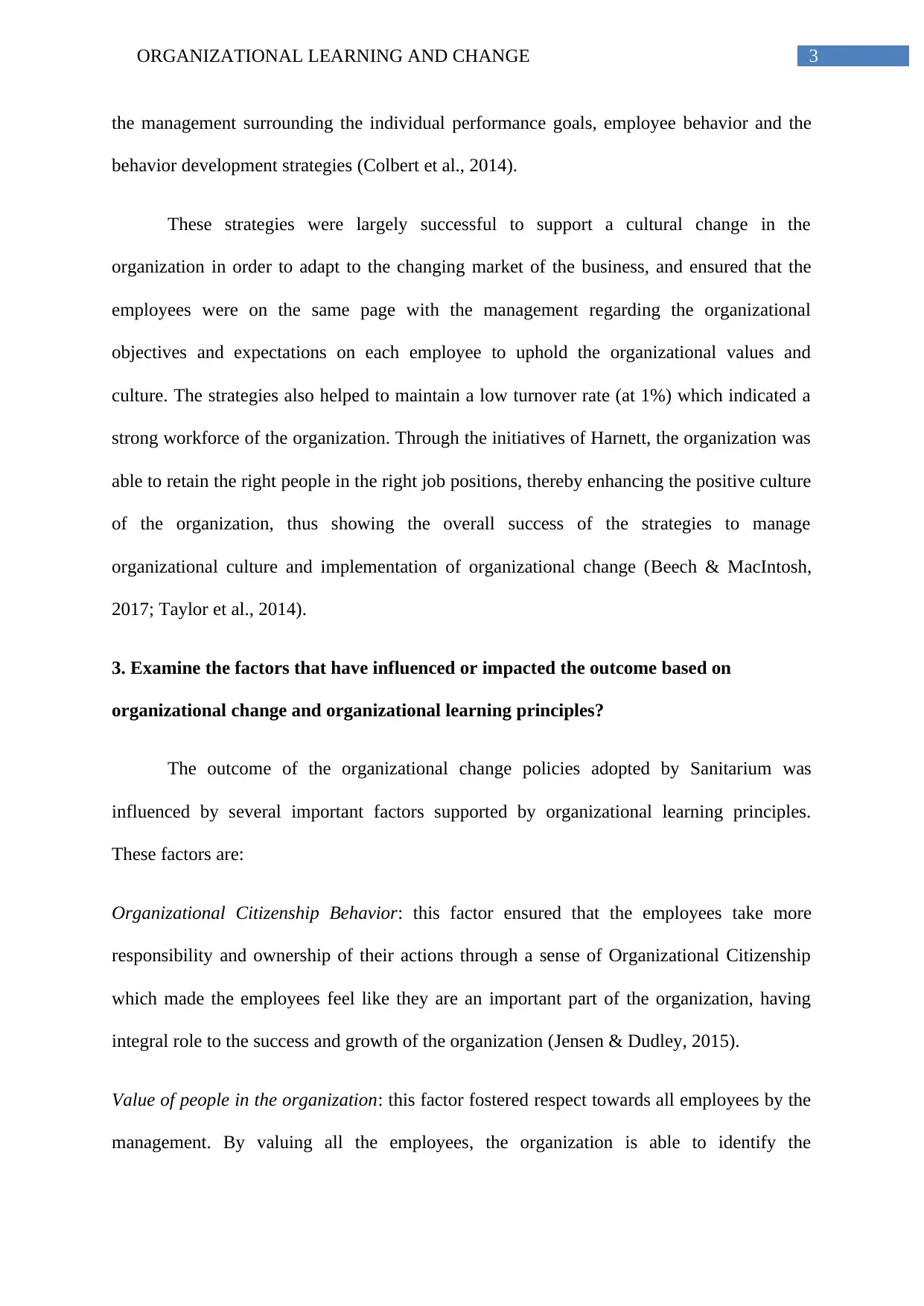
3ORGANIZATIONAL LEARNING AND CHANGE
the management surrounding the individual performance goals, employee behavior and the
behavior development strategies (Colbert et al., 2014).
These strategies were largely successful to support a cultural change in the
organization in order to adapt to the changing market of the business, and ensured that the
employees were on the same page with the management regarding the organizational
objectives and expectations on each employee to uphold the organizational values and
culture. The strategies also helped to maintain a low turnover rate (at 1%) which indicated a
strong workforce of the organization. Through the initiatives of Harnett, the organization was
able to retain the right people in the right job positions, thereby enhancing the positive culture
of the organization, thus showing the overall success of the strategies to manage
organizational culture and implementation of organizational change (Beech & MacIntosh,
2017; Taylor et al., 2014).
3. Examine the factors that have influenced or impacted the outcome based on
organizational change and organizational learning principles?
The outcome of the organizational change policies adopted by Sanitarium was
influenced by several important factors supported by organizational learning principles.
These factors are:
Organizational Citizenship Behavior: this factor ensured that the employees take more
responsibility and ownership of their actions through a sense of Organizational Citizenship
which made the employees feel like they are an important part of the organization, having
integral role to the success and growth of the organization (Jensen & Dudley, 2015).
Value of people in the organization: this factor fostered respect towards all employees by the
management. By valuing all the employees, the organization is able to identify the
the management surrounding the individual performance goals, employee behavior and the
behavior development strategies (Colbert et al., 2014).
These strategies were largely successful to support a cultural change in the
organization in order to adapt to the changing market of the business, and ensured that the
employees were on the same page with the management regarding the organizational
objectives and expectations on each employee to uphold the organizational values and
culture. The strategies also helped to maintain a low turnover rate (at 1%) which indicated a
strong workforce of the organization. Through the initiatives of Harnett, the organization was
able to retain the right people in the right job positions, thereby enhancing the positive culture
of the organization, thus showing the overall success of the strategies to manage
organizational culture and implementation of organizational change (Beech & MacIntosh,
2017; Taylor et al., 2014).
3. Examine the factors that have influenced or impacted the outcome based on
organizational change and organizational learning principles?
The outcome of the organizational change policies adopted by Sanitarium was
influenced by several important factors supported by organizational learning principles.
These factors are:
Organizational Citizenship Behavior: this factor ensured that the employees take more
responsibility and ownership of their actions through a sense of Organizational Citizenship
which made the employees feel like they are an important part of the organization, having
integral role to the success and growth of the organization (Jensen & Dudley, 2015).
Value of people in the organization: this factor fostered respect towards all employees by the
management. By valuing all the employees, the organization is able to identify the
Paraphrase This Document
Need a fresh take? Get an instant paraphrase of this document with our AI Paraphraser
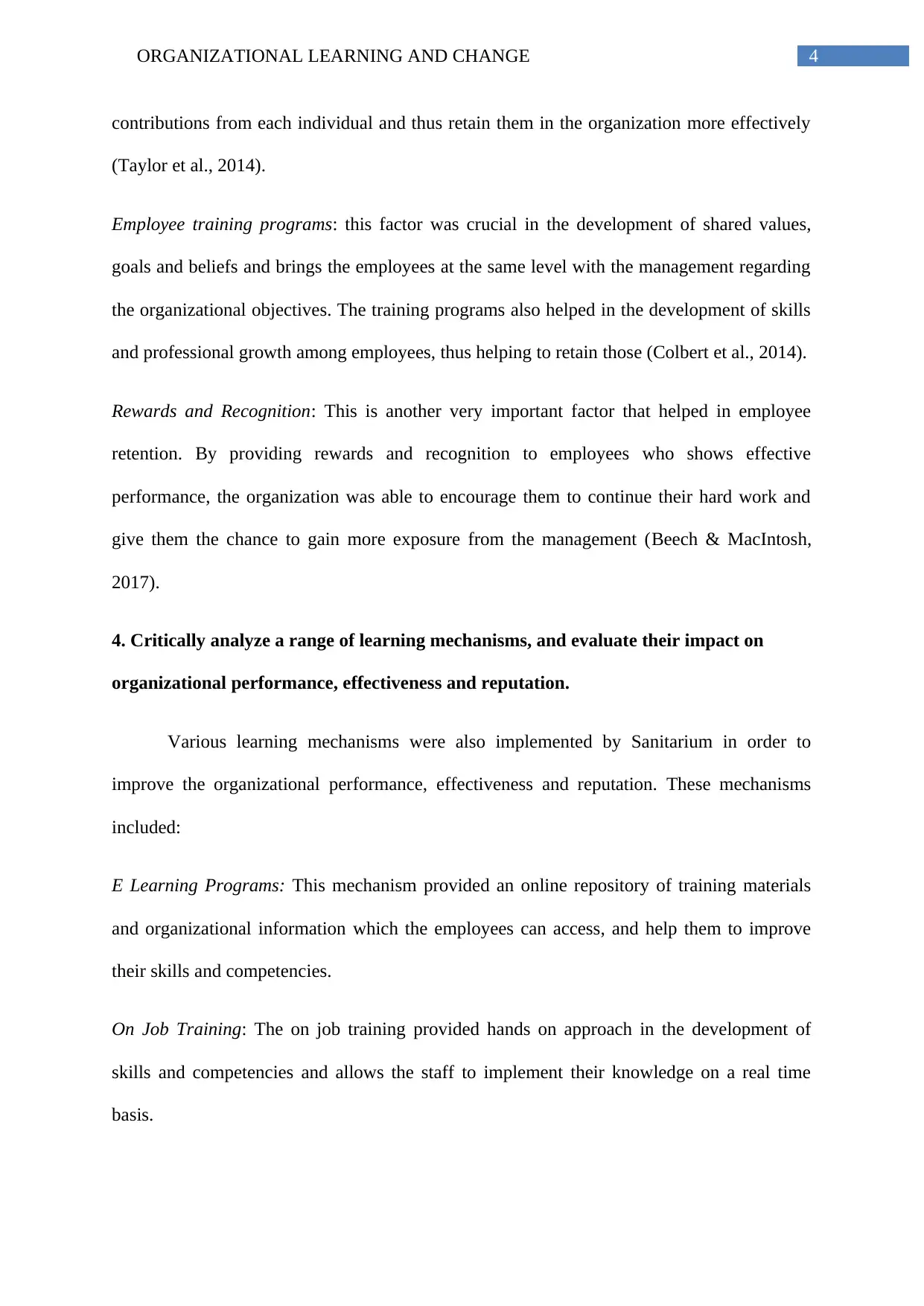
4ORGANIZATIONAL LEARNING AND CHANGE
contributions from each individual and thus retain them in the organization more effectively
(Taylor et al., 2014).
Employee training programs: this factor was crucial in the development of shared values,
goals and beliefs and brings the employees at the same level with the management regarding
the organizational objectives. The training programs also helped in the development of skills
and professional growth among employees, thus helping to retain those (Colbert et al., 2014).
Rewards and Recognition: This is another very important factor that helped in employee
retention. By providing rewards and recognition to employees who shows effective
performance, the organization was able to encourage them to continue their hard work and
give them the chance to gain more exposure from the management (Beech & MacIntosh,
2017).
4. Critically analyze a range of learning mechanisms, and evaluate their impact on
organizational performance, effectiveness and reputation.
Various learning mechanisms were also implemented by Sanitarium in order to
improve the organizational performance, effectiveness and reputation. These mechanisms
included:
E Learning Programs: This mechanism provided an online repository of training materials
and organizational information which the employees can access, and help them to improve
their skills and competencies.
On Job Training: The on job training provided hands on approach in the development of
skills and competencies and allows the staff to implement their knowledge on a real time
basis.
contributions from each individual and thus retain them in the organization more effectively
(Taylor et al., 2014).
Employee training programs: this factor was crucial in the development of shared values,
goals and beliefs and brings the employees at the same level with the management regarding
the organizational objectives. The training programs also helped in the development of skills
and professional growth among employees, thus helping to retain those (Colbert et al., 2014).
Rewards and Recognition: This is another very important factor that helped in employee
retention. By providing rewards and recognition to employees who shows effective
performance, the organization was able to encourage them to continue their hard work and
give them the chance to gain more exposure from the management (Beech & MacIntosh,
2017).
4. Critically analyze a range of learning mechanisms, and evaluate their impact on
organizational performance, effectiveness and reputation.
Various learning mechanisms were also implemented by Sanitarium in order to
improve the organizational performance, effectiveness and reputation. These mechanisms
included:
E Learning Programs: This mechanism provided an online repository of training materials
and organizational information which the employees can access, and help them to improve
their skills and competencies.
On Job Training: The on job training provided hands on approach in the development of
skills and competencies and allows the staff to implement their knowledge on a real time
basis.
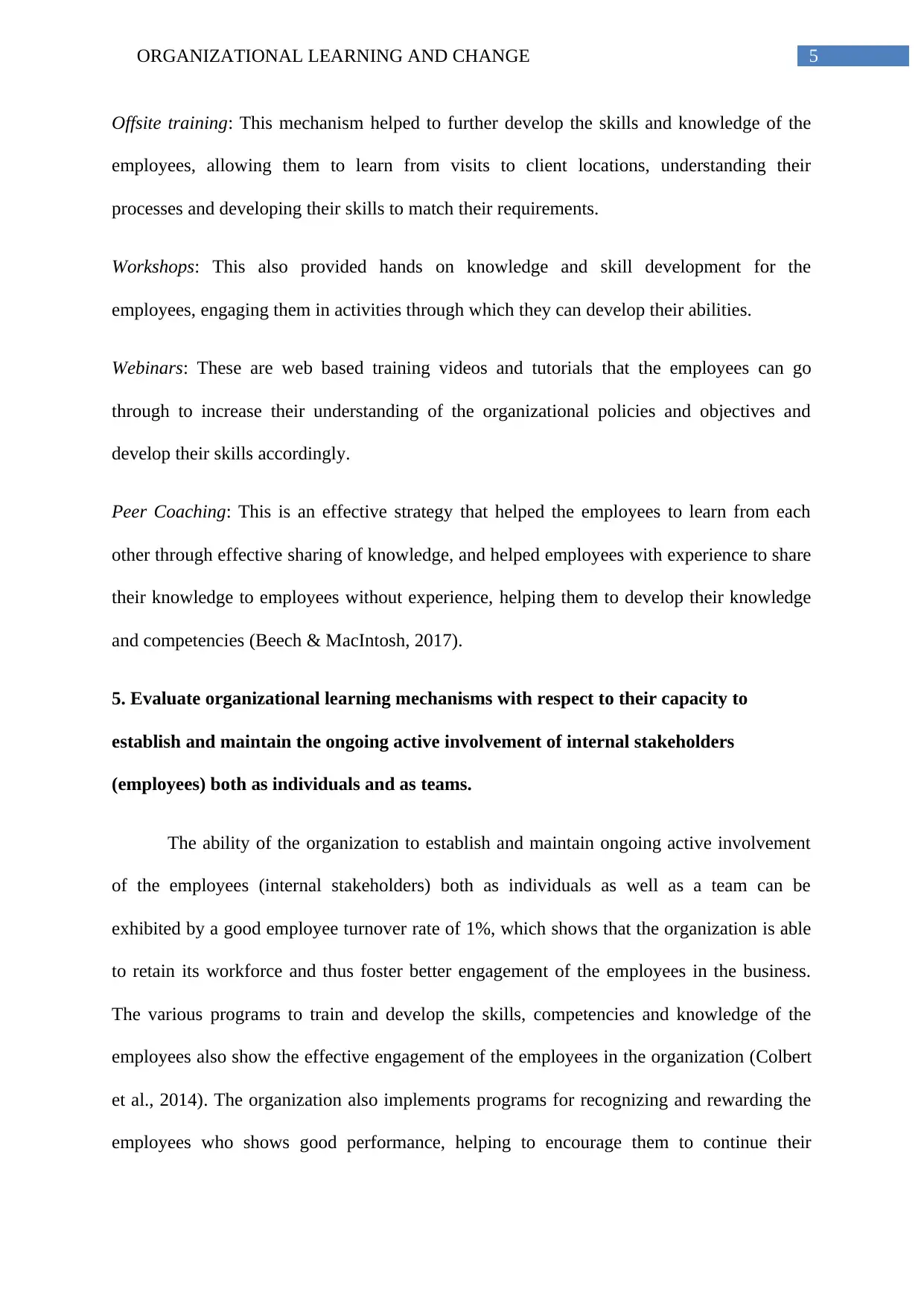
5ORGANIZATIONAL LEARNING AND CHANGE
Offsite training: This mechanism helped to further develop the skills and knowledge of the
employees, allowing them to learn from visits to client locations, understanding their
processes and developing their skills to match their requirements.
Workshops: This also provided hands on knowledge and skill development for the
employees, engaging them in activities through which they can develop their abilities.
Webinars: These are web based training videos and tutorials that the employees can go
through to increase their understanding of the organizational policies and objectives and
develop their skills accordingly.
Peer Coaching: This is an effective strategy that helped the employees to learn from each
other through effective sharing of knowledge, and helped employees with experience to share
their knowledge to employees without experience, helping them to develop their knowledge
and competencies (Beech & MacIntosh, 2017).
5. Evaluate organizational learning mechanisms with respect to their capacity to
establish and maintain the ongoing active involvement of internal stakeholders
(employees) both as individuals and as teams.
The ability of the organization to establish and maintain ongoing active involvement
of the employees (internal stakeholders) both as individuals as well as a team can be
exhibited by a good employee turnover rate of 1%, which shows that the organization is able
to retain its workforce and thus foster better engagement of the employees in the business.
The various programs to train and develop the skills, competencies and knowledge of the
employees also show the effective engagement of the employees in the organization (Colbert
et al., 2014). The organization also implements programs for recognizing and rewarding the
employees who shows good performance, helping to encourage them to continue their
Offsite training: This mechanism helped to further develop the skills and knowledge of the
employees, allowing them to learn from visits to client locations, understanding their
processes and developing their skills to match their requirements.
Workshops: This also provided hands on knowledge and skill development for the
employees, engaging them in activities through which they can develop their abilities.
Webinars: These are web based training videos and tutorials that the employees can go
through to increase their understanding of the organizational policies and objectives and
develop their skills accordingly.
Peer Coaching: This is an effective strategy that helped the employees to learn from each
other through effective sharing of knowledge, and helped employees with experience to share
their knowledge to employees without experience, helping them to develop their knowledge
and competencies (Beech & MacIntosh, 2017).
5. Evaluate organizational learning mechanisms with respect to their capacity to
establish and maintain the ongoing active involvement of internal stakeholders
(employees) both as individuals and as teams.
The ability of the organization to establish and maintain ongoing active involvement
of the employees (internal stakeholders) both as individuals as well as a team can be
exhibited by a good employee turnover rate of 1%, which shows that the organization is able
to retain its workforce and thus foster better engagement of the employees in the business.
The various programs to train and develop the skills, competencies and knowledge of the
employees also show the effective engagement of the employees in the organization (Colbert
et al., 2014). The organization also implements programs for recognizing and rewarding the
employees who shows good performance, helping to encourage them to continue their
⊘ This is a preview!⊘
Do you want full access?
Subscribe today to unlock all pages.

Trusted by 1+ million students worldwide

6ORGANIZATIONAL LEARNING AND CHANGE
participation through salary revisions and a path towards professional growth (through job
promotions). These factors were vital in the maintenance of a high employee retention rate of
the organization and also to engage the employees in a more effective and meaningful
manner (Beech & MacIntosh, 2017).
6. What are your recommendations for the next phase of learning and change?
The strategies implemented by Sanitarium were largely successful to foster learning
and engagement with the employees and orient them towards the organizational values of
individual skills and competencies. Additional strategies can also be recommended which can
further develop the skills of the employees and improve their engagement with the
organization. These strategies can include:
Developing individualized skill development plans for each employee to suit their
individual learning needs.
Providing job rotations to improve engagement and growth by offering employees to
change job roles.
Developing employee networks by connecting the employees taking care of similar or
related job roles.
Offering lateral moves which can allow employees and management to make lateral
moves to different job roles.
Job Shadowing which can help employees to learn about important elements of other
job roles while developing skills in their own roles.
(Taylor et al., 2014; DiPaola & Tschannen-Moran, 2014; Newman et al., 2016)
Conclusion:
participation through salary revisions and a path towards professional growth (through job
promotions). These factors were vital in the maintenance of a high employee retention rate of
the organization and also to engage the employees in a more effective and meaningful
manner (Beech & MacIntosh, 2017).
6. What are your recommendations for the next phase of learning and change?
The strategies implemented by Sanitarium were largely successful to foster learning
and engagement with the employees and orient them towards the organizational values of
individual skills and competencies. Additional strategies can also be recommended which can
further develop the skills of the employees and improve their engagement with the
organization. These strategies can include:
Developing individualized skill development plans for each employee to suit their
individual learning needs.
Providing job rotations to improve engagement and growth by offering employees to
change job roles.
Developing employee networks by connecting the employees taking care of similar or
related job roles.
Offering lateral moves which can allow employees and management to make lateral
moves to different job roles.
Job Shadowing which can help employees to learn about important elements of other
job roles while developing skills in their own roles.
(Taylor et al., 2014; DiPaola & Tschannen-Moran, 2014; Newman et al., 2016)
Conclusion:
Paraphrase This Document
Need a fresh take? Get an instant paraphrase of this document with our AI Paraphraser
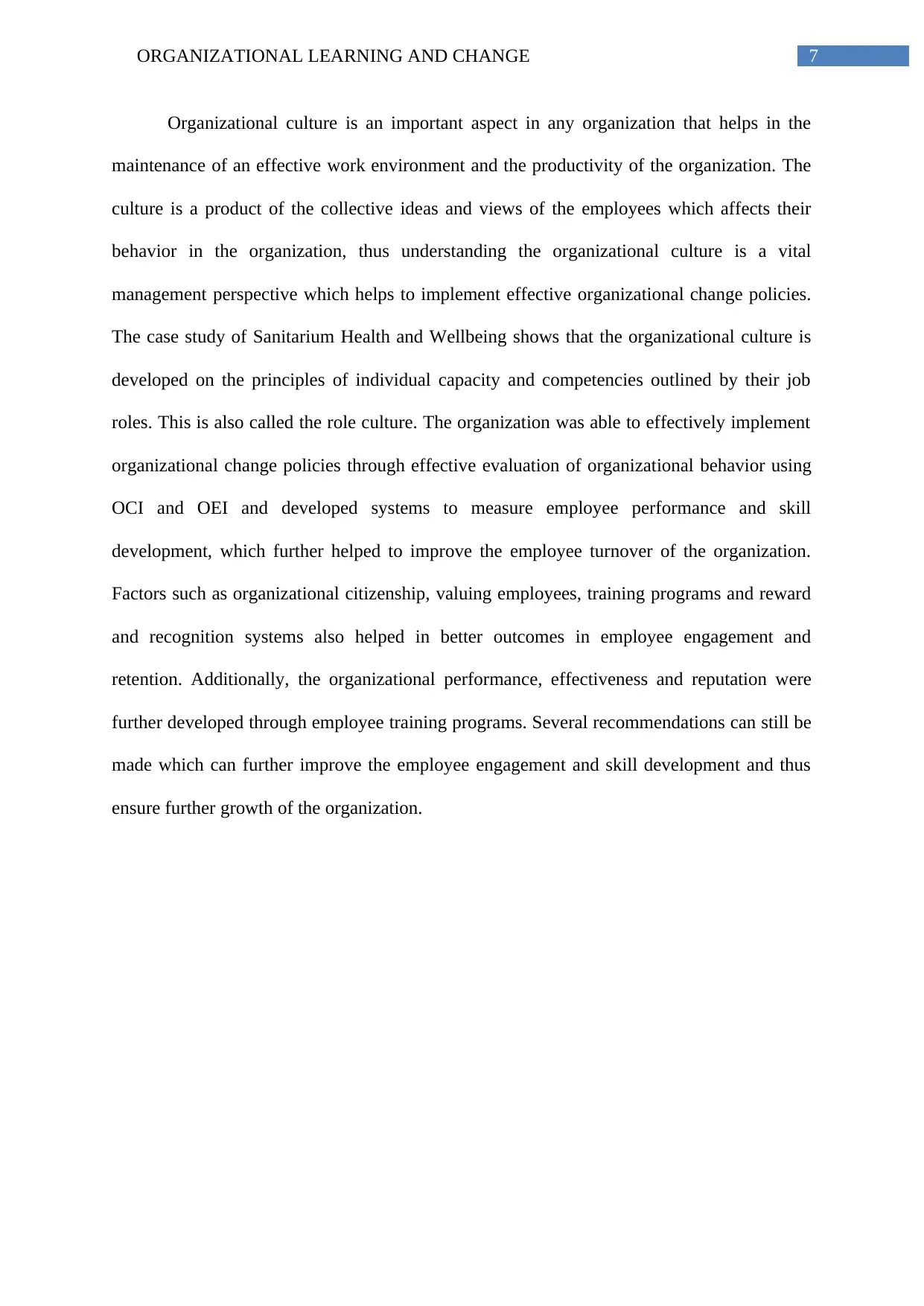
7ORGANIZATIONAL LEARNING AND CHANGE
Organizational culture is an important aspect in any organization that helps in the
maintenance of an effective work environment and the productivity of the organization. The
culture is a product of the collective ideas and views of the employees which affects their
behavior in the organization, thus understanding the organizational culture is a vital
management perspective which helps to implement effective organizational change policies.
The case study of Sanitarium Health and Wellbeing shows that the organizational culture is
developed on the principles of individual capacity and competencies outlined by their job
roles. This is also called the role culture. The organization was able to effectively implement
organizational change policies through effective evaluation of organizational behavior using
OCI and OEI and developed systems to measure employee performance and skill
development, which further helped to improve the employee turnover of the organization.
Factors such as organizational citizenship, valuing employees, training programs and reward
and recognition systems also helped in better outcomes in employee engagement and
retention. Additionally, the organizational performance, effectiveness and reputation were
further developed through employee training programs. Several recommendations can still be
made which can further improve the employee engagement and skill development and thus
ensure further growth of the organization.
Organizational culture is an important aspect in any organization that helps in the
maintenance of an effective work environment and the productivity of the organization. The
culture is a product of the collective ideas and views of the employees which affects their
behavior in the organization, thus understanding the organizational culture is a vital
management perspective which helps to implement effective organizational change policies.
The case study of Sanitarium Health and Wellbeing shows that the organizational culture is
developed on the principles of individual capacity and competencies outlined by their job
roles. This is also called the role culture. The organization was able to effectively implement
organizational change policies through effective evaluation of organizational behavior using
OCI and OEI and developed systems to measure employee performance and skill
development, which further helped to improve the employee turnover of the organization.
Factors such as organizational citizenship, valuing employees, training programs and reward
and recognition systems also helped in better outcomes in employee engagement and
retention. Additionally, the organizational performance, effectiveness and reputation were
further developed through employee training programs. Several recommendations can still be
made which can further improve the employee engagement and skill development and thus
ensure further growth of the organization.
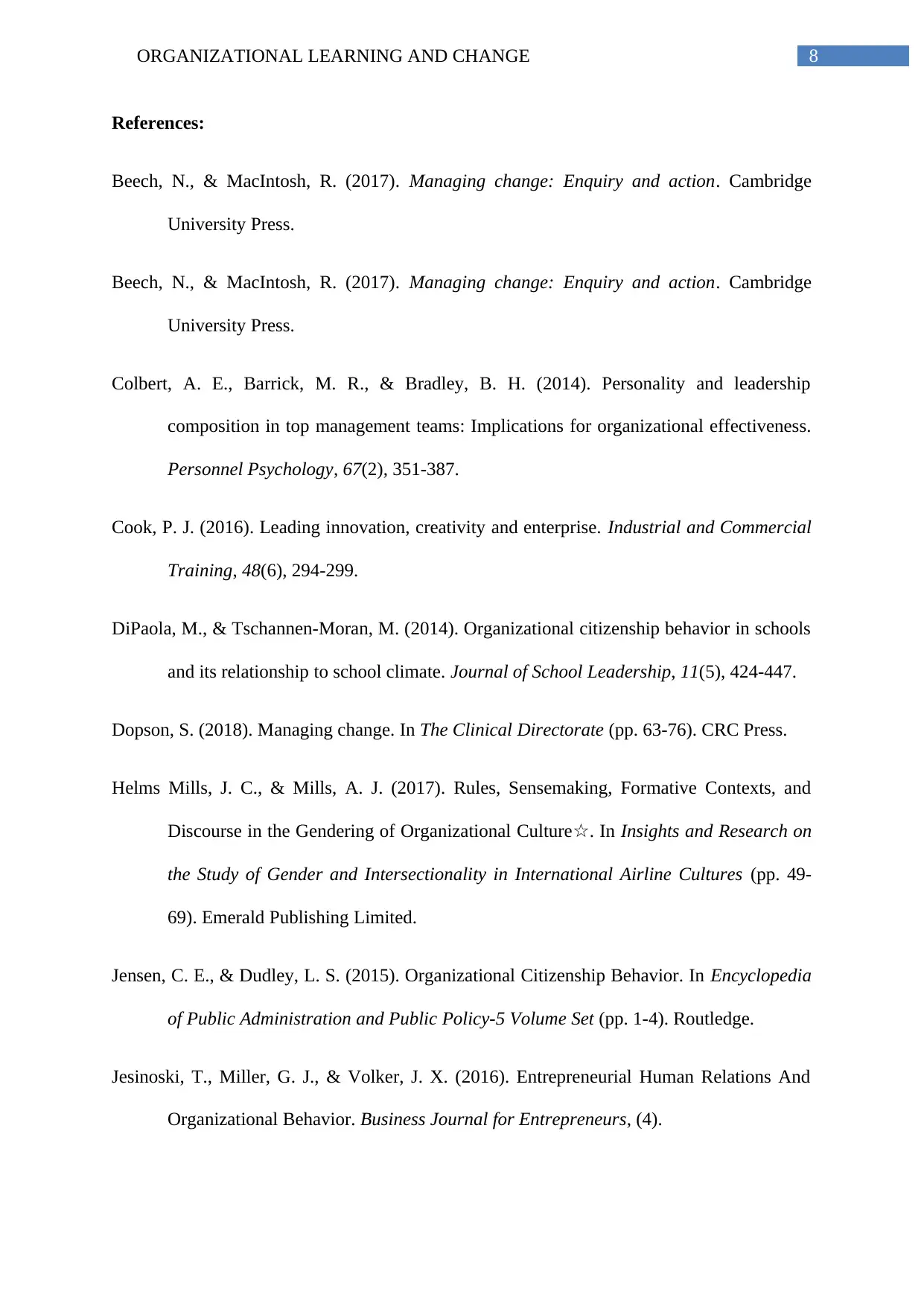
8ORGANIZATIONAL LEARNING AND CHANGE
References:
Beech, N., & MacIntosh, R. (2017). Managing change: Enquiry and action. Cambridge
University Press.
Beech, N., & MacIntosh, R. (2017). Managing change: Enquiry and action. Cambridge
University Press.
Colbert, A. E., Barrick, M. R., & Bradley, B. H. (2014). Personality and leadership
composition in top management teams: Implications for organizational effectiveness.
Personnel Psychology, 67(2), 351-387.
Cook, P. J. (2016). Leading innovation, creativity and enterprise. Industrial and Commercial
Training, 48(6), 294-299.
DiPaola, M., & Tschannen-Moran, M. (2014). Organizational citizenship behavior in schools
and its relationship to school climate. Journal of School Leadership, 11(5), 424-447.
Dopson, S. (2018). Managing change. In The Clinical Directorate (pp. 63-76). CRC Press.
Helms Mills, J. C., & Mills, A. J. (2017). Rules, Sensemaking, Formative Contexts, and
Discourse in the Gendering of Organizational Culture☆. In Insights and Research on
the Study of Gender and Intersectionality in International Airline Cultures (pp. 49-
69). Emerald Publishing Limited.
Jensen, C. E., & Dudley, L. S. (2015). Organizational Citizenship Behavior. In Encyclopedia
of Public Administration and Public Policy-5 Volume Set (pp. 1-4). Routledge.
Jesinoski, T., Miller, G. J., & Volker, J. X. (2016). Entrepreneurial Human Relations And
Organizational Behavior. Business Journal for Entrepreneurs, (4).
References:
Beech, N., & MacIntosh, R. (2017). Managing change: Enquiry and action. Cambridge
University Press.
Beech, N., & MacIntosh, R. (2017). Managing change: Enquiry and action. Cambridge
University Press.
Colbert, A. E., Barrick, M. R., & Bradley, B. H. (2014). Personality and leadership
composition in top management teams: Implications for organizational effectiveness.
Personnel Psychology, 67(2), 351-387.
Cook, P. J. (2016). Leading innovation, creativity and enterprise. Industrial and Commercial
Training, 48(6), 294-299.
DiPaola, M., & Tschannen-Moran, M. (2014). Organizational citizenship behavior in schools
and its relationship to school climate. Journal of School Leadership, 11(5), 424-447.
Dopson, S. (2018). Managing change. In The Clinical Directorate (pp. 63-76). CRC Press.
Helms Mills, J. C., & Mills, A. J. (2017). Rules, Sensemaking, Formative Contexts, and
Discourse in the Gendering of Organizational Culture☆. In Insights and Research on
the Study of Gender and Intersectionality in International Airline Cultures (pp. 49-
69). Emerald Publishing Limited.
Jensen, C. E., & Dudley, L. S. (2015). Organizational Citizenship Behavior. In Encyclopedia
of Public Administration and Public Policy-5 Volume Set (pp. 1-4). Routledge.
Jesinoski, T., Miller, G. J., & Volker, J. X. (2016). Entrepreneurial Human Relations And
Organizational Behavior. Business Journal for Entrepreneurs, (4).
⊘ This is a preview!⊘
Do you want full access?
Subscribe today to unlock all pages.

Trusted by 1+ million students worldwide
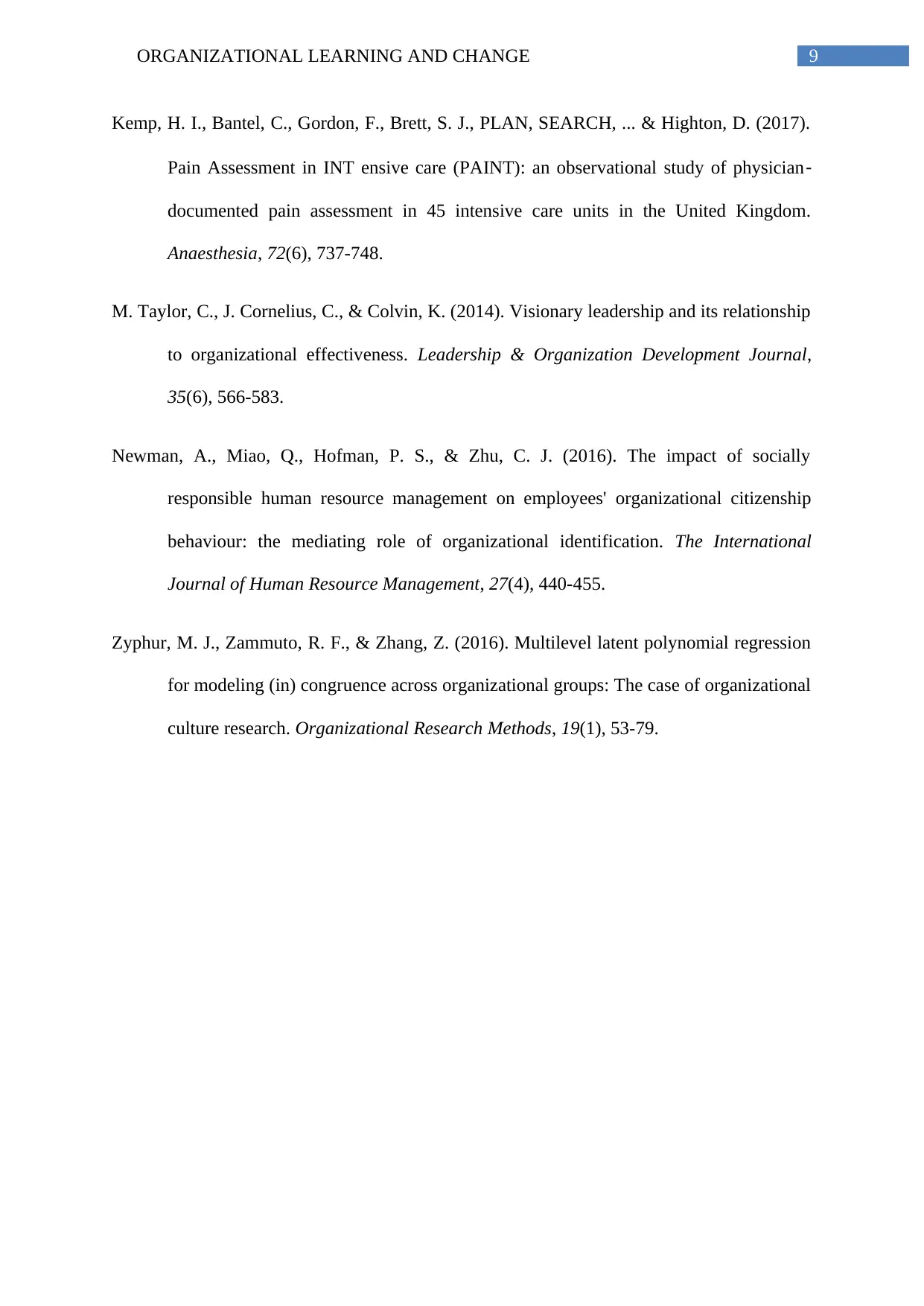
9ORGANIZATIONAL LEARNING AND CHANGE
Kemp, H. I., Bantel, C., Gordon, F., Brett, S. J., PLAN, SEARCH, ... & Highton, D. (2017).
Pain Assessment in INT ensive care (PAINT): an observational study of physician‐
documented pain assessment in 45 intensive care units in the United Kingdom.
Anaesthesia, 72(6), 737-748.
M. Taylor, C., J. Cornelius, C., & Colvin, K. (2014). Visionary leadership and its relationship
to organizational effectiveness. Leadership & Organization Development Journal,
35(6), 566-583.
Newman, A., Miao, Q., Hofman, P. S., & Zhu, C. J. (2016). The impact of socially
responsible human resource management on employees' organizational citizenship
behaviour: the mediating role of organizational identification. The International
Journal of Human Resource Management, 27(4), 440-455.
Zyphur, M. J., Zammuto, R. F., & Zhang, Z. (2016). Multilevel latent polynomial regression
for modeling (in) congruence across organizational groups: The case of organizational
culture research. Organizational Research Methods, 19(1), 53-79.
Kemp, H. I., Bantel, C., Gordon, F., Brett, S. J., PLAN, SEARCH, ... & Highton, D. (2017).
Pain Assessment in INT ensive care (PAINT): an observational study of physician‐
documented pain assessment in 45 intensive care units in the United Kingdom.
Anaesthesia, 72(6), 737-748.
M. Taylor, C., J. Cornelius, C., & Colvin, K. (2014). Visionary leadership and its relationship
to organizational effectiveness. Leadership & Organization Development Journal,
35(6), 566-583.
Newman, A., Miao, Q., Hofman, P. S., & Zhu, C. J. (2016). The impact of socially
responsible human resource management on employees' organizational citizenship
behaviour: the mediating role of organizational identification. The International
Journal of Human Resource Management, 27(4), 440-455.
Zyphur, M. J., Zammuto, R. F., & Zhang, Z. (2016). Multilevel latent polynomial regression
for modeling (in) congruence across organizational groups: The case of organizational
culture research. Organizational Research Methods, 19(1), 53-79.
1 out of 10
Related Documents
Your All-in-One AI-Powered Toolkit for Academic Success.
+13062052269
info@desklib.com
Available 24*7 on WhatsApp / Email
![[object Object]](/_next/static/media/star-bottom.7253800d.svg)
Unlock your academic potential
Copyright © 2020–2025 A2Z Services. All Rights Reserved. Developed and managed by ZUCOL.





